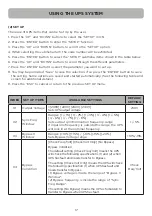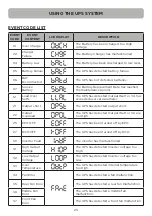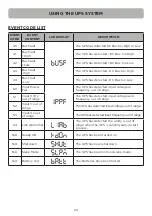
9
1. Power On/Off Button
Master ON/OFF switch for the UPS.
2. Function Buttons
Scroll DOWN, scroll UP, and ENTER.
3. UPS Status / Multifunction LCD Readout
Shows UPS status, information, settings and events.
4. Battery Backup & Surge Protected Outlets
Provide battery backup and surge protection. They ensure power is provided to connected
equipment over a period of time during a power failure.
5. AC Input Inlet
Connect the AC Power cord to a properly wired and grounded outlet.
6. Input Circuit Breaker
Provide input current overload and fault protection.
7. Serial Port
Serial port provides RS-232 communication between the UPS and the computer. The UPS
can control the computer’s shutdown during a power outage through the connection while
the computer can monitor the UPS and change its various programmable settings.
8. USB Port
This is a connectivity port which allows communication and control between the UPS and
the connected computer. It is recommended to install the PowerPanel® Business Agent
software on the PC/Server connected with the USB cord.
9. EPO (Emergency Power Off) Connector
Enables an emergency UPS power-off from a remote location.
10. Relay Output Connector
Convert UPS signals into real potential-free Dry Contacts for industrial control.
11. SNMP/HTTP Network Slot
Slot to install the optional SNMP card for remote network control and monitoring.
12. Extended Runtime Battery Module Connector
Connection for additional CyberPower Battery modules.
13. Output Terminal Block
Connect to your equipment.
14. Output Circuit Breaker
Provide output current overload and fault protection.
OVERVIEW













































